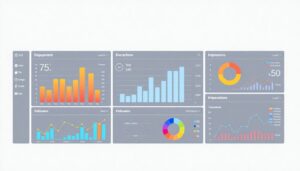Think about it as if you are starting a new lemonade stand. You might take just any old place, and pray for the best. But what if you knew where the thirstiest people hang out? What if you knew what flavors they wanted? This is where the market research comes into play. Its a tool that guides you so you will not be Making Random Moves.
The marketing research is also a digging process, where you are know your customers, and the industry you are working. It allows you to reduce risk, reveal cool opportunities, and see what people want.
Well this guide is all about how to do effective market research. We’ll go through each element step-by-step so you can determine the best options for your business.
Course Outline: Define Your Research Objectives
Nail down, first, what you are trying to learn. It’s like picking out a destination before you even embark on a journey. Without clear expectations, your research may go in a few different directions.
Formulate Your Research Questions
What do you need to know? So good questions lead to good research. Wondering whether your new gadget will sell? Perhaps you’re curious to know who your top competitors are? Or what new stuff is hot and faddish?
Make your questions SMART. That is, they should be Specific, Measurable, Achievable, Relevant and Time-bound. “Will people buy my gadget in the next 6 months?” is a SMART question. “Will my product succeed?” is not.
Identify Your Audience
Who are you trying to reach? Be specific! You can’t please everyone. Is it teenage gamers? Retired teachers? Understanding your audience assists you in receiving the correct responses.
Do you even know who your audience is, and in turn, the data you collect to define that audience? If you’re selling skateboards, polling senior citizens isn’t going to be helpful. Focus on the people who actually want to buy what you are selling.
Set the Key Performance Indicators (KPIs)
How will you know when your research is working? This is where KPIs come in. Those are the things you can track to check if you’re reaching your goals.
Research success is measured with the help of KPIs. Things like what market share you have, whether people like your stuff, or whether they remember your name. And do you take what they want and buy?
Choose Your Research Methods
The best way to discover them depends on what you want to know. Learning can be broadly categorised into two primary research modes. Picking the right one is key.
Primary Research: Collecting New Data
Primary research: It´s when you get data by yourself. It’s talking to people instead of reading about them in a book. The benefit is receiving direct college thoughts aimed at what you want.
Surveys: Direct the same questions to many people. Keep questions clear, simple, not confusing. Use online tools or in-person inquiries. Ask it enough people, and your answers improve.
Pitching: Talk to people (one-to-one). You ask them questions that are more detailed. It’s like a friendly chat where you get honest answers. Come prepared with questions but let the conversation flow.
Focus Groups: Gather some people to discuss your product. This gives you an insight into what people really think in a groups perspective. There’s a lot to be learned from how they communicate with one another.
Observations: Watch people. I’ve got a good dog and did well in school. It is like being a detective. Note how they actually behave, not what they say they do.
Use secondary research which uses existing data.
Secondary research is just using what’s already out there. It can be cheaper and quicker than conducting your own research. Use it to get a wide picture.
Both from you and external sourcesIndustry Reports: These reports tell you about trends, size, scope in your market and other important stuff. Check sources such as IBISWorld and Statista. These also give you the overview.
Government Data: The government has a lot of information. Use it to figure out about populations, jobs and more. The U.S. Census Bureau is a good place to start.
KEY STRATEGIES You’re Not Using: What to The Catch-Up Challenge: Competitive Analysis: Scout Out the Real McCoy What Your Rivals Do Examine their products, pricing, marketing, and sales volume. It’s espionage, but for business savvy.
Collect and Analyze Your Data
Now lets get some facts. This is where things get in the groove. Collecting data starts making things click.
Best Practices for Collecting Data
Be cool when you gather info. Don’t be pushy or sneaky. Keep people’s info safe. Your own thinking should not get in the way of results.
Fact-checking: Verify all information against multiple sources Get rid of mistakes. It renders your research more reliable. Do not make mistakes — use the right tools and methods.
Keep Your Data Clean. Keep everything organized in spreadsheets or databases. This will make it easier to find in the future.
Data Analysis Techniques
So its high time for organizing your data. Transform those numbers and notes into clear ideas. What does your data have to say?
Now Quantitative Analysis: Crunch the numbers Use math to find patterns. It can help you see how things are connected. Just get averages, figure out links, and make strong guesses.
Qualitative: Zoom in on words and narratives. Find common themes and ideas. This enables you to learn about emotions and ideas. Rummage through comments, identify themes, stitch it all together.
SWOT Analysis: Identify your strengths, weaknesses, opportunities, and threats. Defining your strengths and weaknesses, as well as opportunities and threats, is a straightforward approach to sizing up your own business and the competitive landscape it is within that allows you to plan effectively.
Analyze Your Results and Make Conclusions
Now, you consolidate all that information. What does it all mean? That’s the hard part — identifying what matters and what you should be doing.
Spotting Important Trends and Patterns
What’s recurring in your data? Spot these trends. They can tell you where the market is headed. What people say, what people do, what catches on.
Correlation vs. Causation: Just because things happen together doesn’t mean one causes the other. Do not mix them up. One might affect the other (or vice versa).
Actionable Insight Generation
Put into steps you can take what you’ve learned. What will you do differently now? How can you win? Use your data to make intelligent decisions that expand your business.
An Insight By Priority: Not Every Idea Is Created Equally Concentrate on the needles that will create the most change. Consider what’s easy to do and what will yield the best results.
Take Action on Your Findings and Track Results
Don’t shoebox away your research. Use it! Apply your new knowledge in the real world. Next, watch how it works.
Building Insights into Your Business Strategy
Use your research to inform your plans. This might involve adjusting your marketing, producing new products or services, or changing your way of doing business more widely. Explain to everyone why you’re making these changes and how they will help.
Sharing Findings: Report to your team what you learned. Explain the reasons for any changes you are making. A good communication makes sure everyone knows what is going on.
“There was a lot of that tracking,” she said.
Track how your changes are working. Are you achieving the results you want? If not, be prepared to pivot. Keep watching, adjusting and improving.
Changing Your Approach: Things Change Be prepared to adapt your plans as you learn more. Flexibility keeps you ahead. What they do have is the skill of being willing to adapt (which is crucial).
Conclusion
Proper market research is the way to make the right moves. It helps you to understand your customers, identify opportunities, and reduce risks. These steps lead to research that leads to success.
Don’t just guess. Know! Build a better, smarter business with market research So now, go implement these tips and rejoice in the growth of your business!




